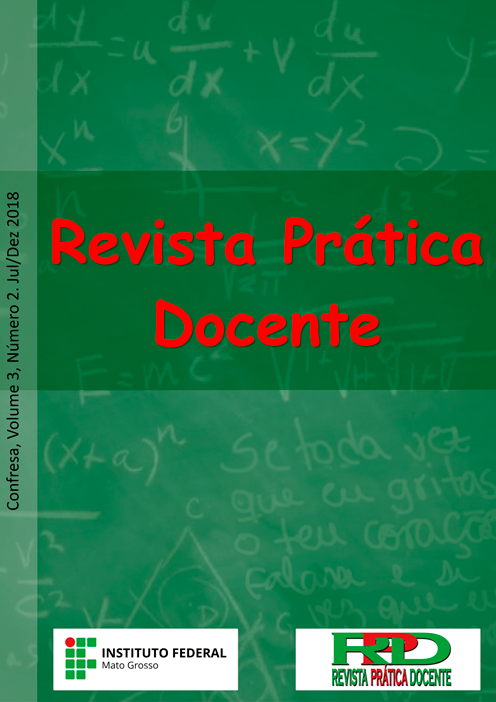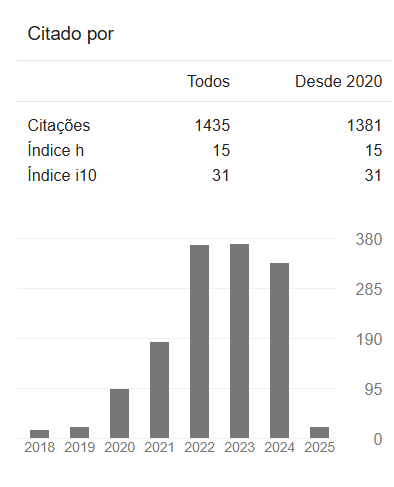MENTAL REPRESENTATIONS USED BY ELEMENTARY SCHOOL STUDENTS ON THE STUDY OF THE HUMAN RESPIRATORY SYSTEM
DOI:
10.23926/RPD.2526-2149.2018.v3.n2.p477-491.id199Keywords:
Representations, Models, LearningAbstract
The article aims to identify and analyze the types of mental representations, based on the mental models theory by Johnson-Laird, used by elementary school students to explain the human respiratory system. The study had a qualitative and quantitative approach, which was characterized by a descriptive and exploratory research. The representations established by the students were categorized as propositional, image, and mental model. Thirty-one students from the 8th grade of a public school in Timon/MA participated in the study. The analyses were carried out through the pictorial representations established by the students before and after the theoretical and expositive lectures on the human body system. The previous knowledge allowed verifying that the students were able to elaborate their mental representations, in the propositional categories (34%), mental image (54%), and mental model (12%). After the knowledge organization, the students showed a greater capacity to establish mental models (69%) and mental image (23%), with a decrease of propositional ones (8%).The results indicated that, with the theoretical and expositive lectures, the students reconstructed their mental representations and acquired scientific knowledge. Therefore, it was observed in this study an evolution in the students' understanding and their mental representations on the respiratory system.
Downloads
Metrics
References
ARRUDA, D. M. Modelos mentais. Instituto Nacional de Tecnologia. Brasília, 2003.
BORGES, A. T. Como evoluem os modelos mentais. Revista Ensaio, Belo Horizonte. v. 1, n.1, p.66-92, jan./jun., 1999. DOI: https://doi.org/10.1590/1983-21171999010107
DUSSO, L.; et al. Modelização: uma possibilidade didática no ensino de Biologia. Revista Ensaio, Belo Horizonte. v.15, n. 2, maio/ago., p. 29-44, 2013. DOI: https://doi.org/10.1590/1983-21172013150203
ERROBIDART, N. C. G.; et al. Modelos mentais e representações utilizadas por estudantes do ensino médio para explicar ondas. Revista Electrónica de Enseñanza de las Ciencias, v. 12, n. 3, p.440-457, 2013.
JOHNSON-LAIRD, P. Modelos mentais em ciência cognitiva. In: NORMAN. D. (Ed.). Perspectivas de la Ciência Cognitiva. Barcelona: Paidós, 1987.
KRAPAS, S.; ALVES, F.; CARVALHO, L. R. Modelos mentais e a lei de Gauss. Investigações em Ensino de Ciências, v. 5, p. 1, p. 7-21, 2000.
KRAPAS, S. et al. Modelos: uma análise de sentidos na literatura de pesquisa em ensino de Ciências. Investigações em Ensino de Ciências, v. 2 n. 3, p. 185-205, 1997.
KRAUSE, F. C. Modelos tridimensionais em Biologia e aprendizagem significativa na Educação de Jovens e Adultos (EJA) no Ensino Médio. 186f. 2012. Dissertação (Mestrado em Educação). Universidade de Brasília, Brasília, 2012.
LAGRECA, M. C. B.; MOREIRA, M. A. Tipos de representações mentais utilizadas por estudantes de Física Geral na área de mecânica clássica e possíveis modelos mentais nessa área. Revista Brasileira de Ensino de Física, v. 21, n. 1, p. 202-215, 1999.
LEDERMAN, L.; D'OLIVAL, F. C. Tempo de ciências 8. 2. ed, São Paulo: Editora do Brasil, 2015.
LÜDKE M.; ANDRÉ, M. E. D. A. Pesquisa em educação: abordagens qualitativas. 2. ed. São Paulo: EPU, 2013
MOREIRA, M. A. Modelos mentais. Investigações em Ensino de Ciências, v. 1, n. 3, p.193-232, 1996.
MOREIRA, M. A; GRECA, I. M.; PALMERO, M. L. R. Modelos mentales y modelos conceptuales en la enseñanza y aprendizaje de las Ciencias. Revista Brasileira de Pesquisa em Educação em Ciências, Porto Alegre, v. 2, n. 3, p. 37-57, 2002.
MOREIRA, M. A; LAGRECA, M. C. B. Representações mentais dos alunos em mecânica clássica: três casos. Investigações em Ensino de Ciências, v. 3, n. 2, p. 83-106, 1998.
MOREIRA, M. A; MASINI, E. F. S. Aprendizagem significativa: a teoria da aprendizagem de David Ausubel. 2. ed. São Paulo: Centauro Editora, 2009.
PALMERO, M. L. R.; ACOSTA, J. M.; MOREIRA, M. A. La teoría de los modelos mentales de Johnson-Laird y sus principios: una aplicación con modelos mentales de célula em estudiantes del curso de orientación universitária. Investigações em Ensino de Ciências, v. 6, n. 3, p. 243-268, 2001.
PALMERO, M. L. R.; MOREIRA, M. A. Modelos mentales vs esquemas de célula. Investigações em Ensino de Ciências, v. 7, n. 1, p. 77-103, 2002.
PRODANOV, C. C.; FREITAS, E. C. Metodologia do trabalho científico: métodos e técnicas da pesquisa e do trabalho acadêmico. 2. ed. Novo Hamburgo: Feevale, 2013.
QUINTO, T.; FERRACIOLI, L. Modelos e modelagem no contexto do ensino de Ciências no Brasil: uma revisão de literatura de 1996-2006. Revista Didática Sistêmica, v. 8, jul./dez., p. 80-100, 2008.
RAMALHO, F. A. Modelos e representações análogas de alunos da educação de jovens e adultos - EJA - no ensino de ciências. 2009. 153 f. Mestrado (Educação Tecnológica). Centro Federal de Educação Tecnológica de Minas Gerais. Belo Horizonte, 2009.
SOUZA, E. S. R. A formação de modelos mentais na sala de aula. Revista EXITUS, v. 3, n.1, jan./Jun., p. 169-184, 2013.
TALAMONI, A. C. B.; BERTOLLI FILHO, C. A formação de conceitos no ensino de Biologia e Química: corpo e vida nas representações de estudantes do ensino fundamental. In: CALDEIRA, A. M. A. (Org.) Ensino de Ciências e Matemática, II: temas sobre a formação de conceitos. São Paulo: Editora UNESP, 2009.
TAUCEDA, K. C.; DEL PINO, J. C. Modelos e outras representações mentais no estudo do DNA em alunos do ensino médio. Investigações em Ensino de Ciências, v. 15, n. 2, p. 337-354, 2010.
TAUCEDA, K. C.; NUNES, V. M.; DEL PINO, J. C. O livro didático e as representações mentais de Bioquímica e Biofísica em alunos do Ensino Médio. Experiências em Ensino de Ciências, v. 6, n. 1, p. 57-68, 2011.
Downloads
Published
How to Cite
Issue
Section
License
Copyright (c) 2023 A Revista Prática Docente tem o direito de primeira publicação

This work is licensed under a Creative Commons Attribution-NonCommercial 4.0 International License.
Authors who publish in this journal agree to the following terms:
- Authors retain the copyright and grant the journal the right of first publication, with the paper simultaneously licensed under the Licença Creative Commons Attribution allows the sharing of the work with acknowledgment of authorship and initial publication in this journal.
- Authors are authorized to take additional contracts separately, for non-exclusive distribution of the version of the work published in this journal (e.g. publish in institutional repository or as a book chapter), with acknowledgment of authorship and initial publication in this journal.











